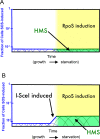Mutability and importance of a hypermutable cell subpopulation that produces stress-induced mutants in Escherichia coli
- PMID: 18833303
- PMCID: PMC2543114
- DOI: 10.1371/journal.pgen.1000208
Mutability and importance of a hypermutable cell subpopulation that produces stress-induced mutants in Escherichia coli
Abstract
In bacterial, yeast, and human cells, stress-induced mutation mechanisms are induced in growth-limiting environments and produce non-adaptive and adaptive mutations. These mechanisms may accelerate evolution specifically when cells are maladapted to their environments, i.e., when they are are stressed. One mechanism of stress-induced mutagenesis in Escherichia coli occurs by error-prone DNA double-strand break (DSB) repair. This mechanism was linked previously to a differentiated subpopulation of cells with a transiently elevated mutation rate, a hypermutable cell subpopulation (HMS). The HMS could be important, producing essentially all stress-induced mutants. Alternatively, the HMS was proposed to produce only a minority of stress-induced mutants, i.e., it was proposed to be peripheral. We characterize three aspects of the HMS. First, using improved mutation-detection methods, we estimate the number of mutations per genome of HMS-derived cells and find that it is compatible with fitness after the HMS state. This implies that these mutants are not necessarily an evolutionary dead end, and could contribute to adaptive evolution. Second, we show that stress-induced Lac(+) mutants, with and without evidence of descent from the HMS, have similar Lac(+) mutation sequences. This provides evidence that HMS-descended and most stress-induced mutants form via a common mechanism. Third, mutation-stimulating DSBs introduced via I-SceI endonuclease in vivo do not promote Lac(+) mutation independently of the HMS. This and the previous finding support the hypothesis that the HMS underlies most stress-induced mutants, not just a minority of them, i.e., it is important. We consider a model in which HMS differentiation is controlled by stress responses. Differentiation of an HMS potentially limits the risks of mutagenesis in cell clones.
Conflict of interest statement
The authors have declared that no competing interests exist.
Figures




Similar articles
-
The sigma(E) stress response is required for stress-induced mutation and amplification in Escherichia coli.Mol Microbiol. 2010 Jul;77(2):415-30. doi: 10.1111/j.1365-2958.2010.07213.x. Epub 2010 May 19. Mol Microbiol. 2010. PMID: 20497332 Free PMC article.
-
What limits the efficiency of double-strand break-dependent stress-induced mutation in Escherichia coli?J Mol Microbiol Biotechnol. 2011;21(1-2):8-19. doi: 10.1159/000335354. Epub 2012 Jan 13. J Mol Microbiol Biotechnol. 2011. PMID: 22248539 Free PMC article.
-
A switch from high-fidelity to error-prone DNA double-strand break repair underlies stress-induced mutation.Mol Cell. 2005 Sep 16;19(6):791-804. doi: 10.1016/j.molcel.2005.07.025. Mol Cell. 2005. PMID: 16168374
-
Adaptive mutation and amplification in Escherichia coli: two pathways of genome adaptation under stress.Res Microbiol. 2004 Jun;155(5):352-9. doi: 10.1016/j.resmic.2004.01.020. Res Microbiol. 2004. PMID: 15207867 Review.
-
Mutation as a stress response and the regulation of evolvability.Crit Rev Biochem Mol Biol. 2007 Sep-Oct;42(5):399-435. doi: 10.1080/10409230701648502. Crit Rev Biochem Mol Biol. 2007. PMID: 17917874 Free PMC article. Review.
Cited by
-
Hypermutation in single-stranded DNA.DNA Repair (Amst). 2020 Jul-Aug;91-92:102868. doi: 10.1016/j.dnarep.2020.102868. Epub 2020 May 18. DNA Repair (Amst). 2020. PMID: 32438271 Free PMC article. Review.
-
Role of Ribonucleotide Reductase in Bacillus subtilis Stress-Associated Mutagenesis.J Bacteriol. 2017 Jan 30;199(4):e00715-16. doi: 10.1128/JB.00715-16. Print 2017 Feb 15. J Bacteriol. 2017. PMID: 27920297 Free PMC article.
-
Stress-induced modulators of repeat instability and genome evolution.J Mol Microbiol Biotechnol. 2011;21(1-2):36-44. doi: 10.1159/000332748. Epub 2012 Jan 13. J Mol Microbiol Biotechnol. 2011. PMID: 22248541 Free PMC article. Review.
-
Oxygen and RNA in stress-induced mutation.Curr Genet. 2018 Aug;64(4):769-776. doi: 10.1007/s00294-017-0801-9. Epub 2018 Jan 2. Curr Genet. 2018. PMID: 29294174 Free PMC article. Review.
-
The sigma(E) stress response is required for stress-induced mutation and amplification in Escherichia coli.Mol Microbiol. 2010 Jul;77(2):415-30. doi: 10.1111/j.1365-2958.2010.07213.x. Epub 2010 May 19. Mol Microbiol. 2010. PMID: 20497332 Free PMC article.
References
Publication types
MeSH terms
Grants and funding
LinkOut - more resources
Full Text Sources

